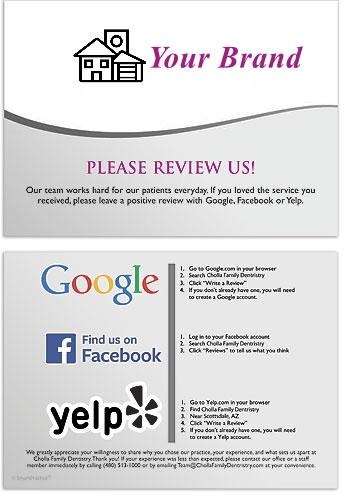June 25, 2019
This is the third part of a three-part series on reputation management. If you haven’t yet, read Part I and Part II. In this series, we will give you all of the information necessary to use this powerful tool to grow your business dramatically without spending thousands of dollars needlessly. Small business owners who ignore the importance of their online reputation may suffer a drop in business and never know what happened or why.
Part Three: Obtaining Customer Reviews, Monitoring Your Reviews, and How to Handle Negative Reviews
In this final part of the series we will discuss how you can get your customers to provide you with online reviews to help build your business as well as how to respond to a negative review in a way that turns a negative review into a positive and actually helps your online business reputation (think turning lemons into lemonade).
First, you need to develop a method to ask for reviews from customers in a way that makes them feel comfortable posting an honest evaluation of your performance. One way is to just ask! When you’re face-to-face and concluding business where you anticipate their satisfaction is highest, simply say, “Thanks for giving me your business, it would be very helpful if you could leave me a 5-star review on [Google, Yelp, Facebook] if you’ve been pleased with my work.”
Next, email your customer a day or two after you have completed the service, or include a review request when you send them concluding documents or reports. In the email, thank them for entrusting you with your business. Be sincere because they know they could have selected someone else and you need to convey gratitude for their trust and business. Ask them to write a review by closing the email with something like this: “If you are happy with the service I provided, I would be grateful if you would write a 5-star review for me on [Google, Yelp, Facebook]”. Click on this tutorial to learn how to furnish your customers with a clickable link to easily leave you positive reviews. By making it easy to write you a review, you increase the probability they will do so.
You can also add the review link to your website, or to the back of your business card as another way to ask for reviews. Here’s a business card example:
If you get an especially positive review, consider asking the reviewer if they would be willing to write a slightly longer testimonial you can use on your own website to promote your business to potential customers. Testimonials are typically longer than reviews and you can pick where testimonials are posted. One small business offered a $5 Starbucks gift card to reviewers willing to write testimonials.
Research indicates over 80% of consumers trust online reviews posted by total strangers as much as they trust personal recommendations from friends. This fact is why it is imperative you learn how to manage your online reviews.
Next, it is important that you claim and optimize your review pages. When you search for your business name online, you may come across a review page on Yelp or Google you did not set up yourself. Find the button that says “Claim This Page” and claim the page as your own. You will then have to go through the steps to verify your business so you can update your information on the page. You want to claim these pages so you can control the online reputation you have worked so hard to create. By claiming these pages, you can now also respond to reviews you were not seeing before you claimed these pages. Remember – use the exact same address, hours, phone and other basic business information on each claimed page for the best result.
If you haven’t done this before, here’s how to:
While you’re claiming and setting up your business, be sure to turn on notifications so that you’re aware when reviews are posted to your business pages. Here’s more information on managing notifications on Google, Yelp, and Facebook.

Some sites like Google and Yelp allow business owners (or anyone) to post photographs. People are visual. It is a great idea to post a few beautifully-composed, well-lit photographs that represent your business well. Here’s a detailed guide for Google My Business photos with lots of ideas.
Now that you have control of your pages and are getting reviews from your customers, you will need to allocate time at least twice a week to read and respond to ALL reviews. At the beginning you’ll be “getting to know” the cadence of your reviews and your notifications. You should be making sure that you are seeing all your new review notifications, are taking time to respond, and just “keeping an eye on” your digital shingle on these sites.
Research shows over 50% of customers who take time to post a review expect a response. For those who post a negative review the percentage is much higher and, in some cases, exceeds 90%.
For positive reviews, a simple “Thank you for your business. We hope you will remember us whenever you or your friends need our services in the future” is sufficient.
For negative reviews the process is a bit different. Yes, no matter how good your business is or how hard you work, you will get negative reviews. First, and most importantly, do not immediately type a reply and hit send. Most people are emotional when they read a negative review and that is the worst time to write a reply. Take a deep breath, stay calm, and reread the review. Then take a minute and look at your records to see if there might just be some truth in what the reviewer wrote. Face it, we all make mistakes and when we do we need to acknowledge them, learn from them, and forget them. If you decide there might be some truth in the review, your reply needs to read something like this:
“Mr. Smith, we are sorry our service was not up to the standards we strive for and we are grateful you brought this to our attention so we can work even harder to make every customer a satisfied customer. We will be contacting you right away to work out how we can make it right.”
If you feel you are not at fault, you still need to reply without escalating the situation. Do not get combative because you have a business to run and the reviewer may have nothing better to do than engage in a never-ending online battle which your business will likely lose. “Don’t feed the trolls.” Here is one example of a response to a review where you know the customer is totally wrong.
“Ms. Jones, we are sorry you are disappointed with the services we provided. Here at [name of company] we strive to satisfy every customer’s needs and we regret when we fall short.”
By acknowledging their complaint, but not admitting any fault, you leave them without any reason to continue to write anything else.
Here is a short list of some of the main reasons customers write bad or negative reviews:
- You fail to return phone calls or email messages on a timely basis. This is especially true if you drag your heels replying after you take their payment.
- You bill more than the estimate without offering any explanation, either in writing or by phone.
- You make a mess while working in someone else’s home or office and fail to clean up after yourself.
- You accidentally break something and try to hide it instead of admitting it.
- You show up late and fail to offer any explanation or apologize in any way.
Even if you do everything right to build your online brand and reputation, carefully monitor it, work diligently to get positive reviews, reply to all reviews, and own your mistakes, you are going to get a review that is just plain wrong. It may happen by accident when a reviewer posts a bad review on your page instead of the right page (maybe the names are similar) or it can happen intentionally when a former disgruntled employee decides to trash your business. Sadly, it could even be from someone working for a competitor who wants to help their own business by hurting yours. When it happens, you have to act quickly before too many people read it and believe it.
Some social media websites have built-in tools to help you “flag” a false or inflammatory review. For example, on Yelp there are 4 steps to take to flag and report a review.
- Click the flag icon (Report Review) in the bottom right-hand corner of the review.
- From the drop-down menu, select the most relevant option shown based on the issue most closely identified with the review.
- Write a concise, factual description explaining why you flagged the review.
- Respond to the review, but even though it is false or inflammatory, do not respond in kind. Instead, point out what is false or inflammatory and if you know the source is a former employee or a competitor, feel free to point it out without mentioning them by name. You can even ask the reviewer some questions so anyone reading the review and your response will see you care enough about your business and your online reputation to respond to even obviously false reviews.
To sum up this entire three-part series, we have shown you why your online business reputation is important, how to find out what your online business reputation is, how to build the online reputation you want (and need) for your business, how to monitor and manage your online business reputation, and how to respond to reviews of all flavors. Please let us know if you enjoyed this series, and if you have any suggestions for other topics you feel would be of interest to small business owners, feel free to send them to us.
Finally, here is a link to an article containing some of the best responses to reviews (good and bad) ever written. Enjoy!
Now, get back to work and enjoy how your new online business reputation makes the phone ring.
Sources:
https://www.textrequest.com/blog/negative-customer-reviews/
https://marketing.sfgate.com/blog/how-to-encourage-positive-online-reviews-from-your-customers
https://www.bigcommerce.com/ecommerce-answers/what-is-astroturfing/
https://marketingland.com/how-to-turn-negative-online-reviews-into-marketing-wins-248230
https://www.reviewtrackers.com/guides/examples-responding-reviews/



